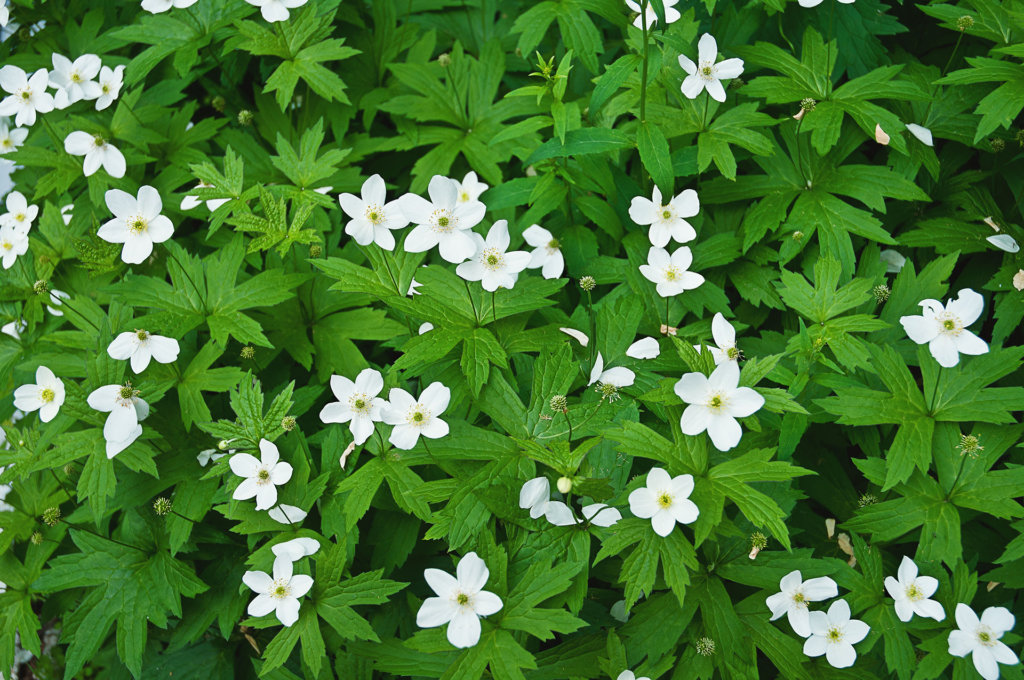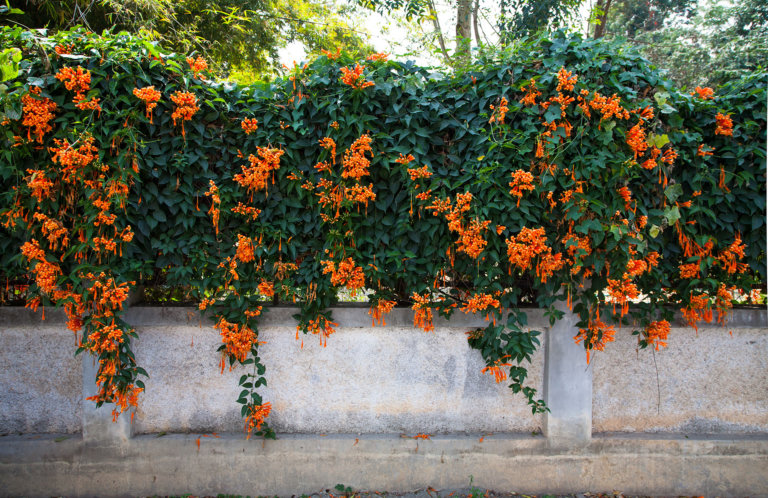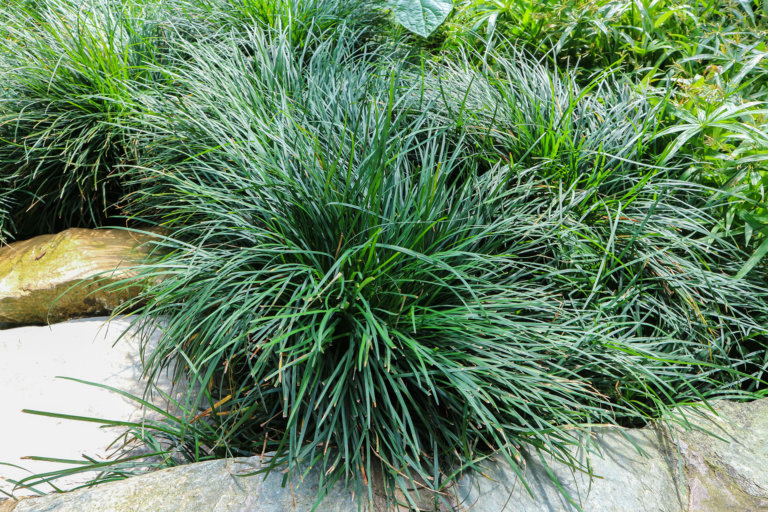Shade-loving ground cover plants are the perfect solution for a variety of landscaping issues such as:
- Weed growth under trees and bushes
- Soil erosion
- Lack of textural interest
- Coverage of hard-to-grow areas
- Lack of color
Here are our top 15 ground covers for shaded areas, as well as a few that can handle full sun. Whichever variety of ground cover you choose, they’ll help your garden become the envy of the neighborhood!
#1: Hostas
Hostas have more than 3,000 registered varieties within 70 species that offer a huge array of foliage color, height, and textures. Most hostas flower, with purple or white blooms forming on a long center shoot.
Leaf colors range from a bright yellow-green to variegated to blue-greens. Overall plant height (up to 3 feet), leaf shape, and texture are so diverse, planting different varieties can be a one-and-done solution to offset visual boredom.
Hostas spread by new rhizomes, which means they are easy to divide every few years. The foliage dies in winter and reappears in spring.
USDA growing zones: 3-9
#2: Creeping Myrtle (Vinca minor)
Creeping myrtle is a low-growing, yet fast-spreading, evergreen groundcover that features thick and shiny deep green leaves on tendril-like stems. In the spring, they burst with purple/blue small flowers that brighten dull areas.
The 6-inch tall, matlike growth especially benefits hilly terrain as it both covers hard-to-grow areas, while reducing soil erosion. The evergreen foliage also requires no pruning to keep it looking neat all year.
USDA growing zones: 4-9
#3: Japanese Pachysandra (Pachysandra terminalis)
Japanese pachysandra, also known as Spurge, is a perennial evergreen that looks sharp all year. The foliage grows into a weed-deterring, thick carpet of textural green leaves that hid a myriad of garden flaws like tree roots, rocky areas, or drainage pipes.
In spring, small white flowers emerge, which brighten shady spots. The plant is drought-tolerant, fast-growing, and easy to propagate using cuttings. Pachysandra grows 6 to 12-inches tall and requires little pruning. The root system helps hold soil in place, making it a prime choice for hilly terrain.
USDA growing zones: 5-9
#4: Ajuga (Ajuga reptans) or Carpet Bugleweed
Ajuga is a member of the mint family that will quickly fill in bare spots while snuffing out weed growth and deterring soil erosion. The foliage is a vibrant green with hints of blue, purple, and sometimes pink. Flowers are either purple or white.
The matlike growth reaches 8 inches tall and tends to take over areas quickly, so solid borders are a must. The plant is a perennial evergreen, which means foliage remains green all year.
USDA growing zones: 3-9
#5: Golden Star (Chrysogonum virginianum)
Golden star ground cover is one plant that blooms spring through fall. The green foliage highlights bright starlike yellow flowers that form a carpet of beauty. Better yet, the plant can tolerate different soils and requires little maintenance.
The dense mat of foliage holds onto even steep terrain but is also excellent for use in borders as it grows only 6 to 12 inches tall. While a perennial, the plant acts more evergreen, with leaves staying green unless hit with extreme cold.
USDA growing zones: 3-9
#6: Lily-of-the-valley (Convallaria majalis)
Lily-of-the-valley is a fast-spreading, almost invasive type of ground cover that likes moist soil. In full shade, the plant will produce fewer of the distinct fragrant white flowers.
The best feature of this plant is the root system that grows deeper and denser than other ground covers. The root spread helps deter weed growth, but can also choke out desirable plants. The foliage tops out at 12 inches and dies off each winter.
USDA growing zones: 3-9
#7: Sweet Woodruff (Galium odoratum)
Sweet Woodruff is a herb that grows well in deep shade and is easy to maintain. This plant is edible and survives in most soil conditions. Both the leaves and the white flowers feature an interesting spear-like design.
The plant spreads swiftly and can become invasive. The 8 to 12 inches foliage creates a thick carpet that can handle foot traffic, making it an ideal alternative to grass. It also thrives under pine trees. It dies back in winter, but can also go dormant during hot, dry summers as it cannot tolerate lack of water.
USDA growing zones: 4-8
#8: Spotted Deadnettle (Lamium maculatum)
Spotted deadnettle grows 6 to 12 inches high and can spread 2 feet wide. The silver-tone foliage is unusual and stands out among expanses of green. In warmer regions, it grows like an evergreen and spreads efficiently into bare spots.
This perennial plant flowers in pink, lavender, white, or purple around June. The plant also fends off garden pests and diseases. In cold regions, expect foliage to die off in winter.
USDA growing zones: 3-8
#9: English Ivy (Hedera helix)
English Ivy is a woody vine that grows in difficult-to-garden places, but many regions consider it an invasive species. The foliage grows 8 inches in height and can cling to cliffs, hills, trellises, and trees but takes longer to “fill in” than other ground covers.
Leaves can be either solid green or variegated with some white or yellow. On mature English Ivy, the plants form black berries that are toxic. The plant flowers in May-June with hard-to-spot greenish-yellow blooms. The plant is evergreen, so it’s perfect for full-year coverage of unsightly areas.
USDA growing zones: 4-9
#10: Bergenia (Bergenia Cordifolia)
Bergenia is a perennial with thick, shiny, heart-shaped leaves that can turn orange or red in cooler regions during the fall. Deep pink flowers bloom in late spring and often re-bloom again in the fall.
The foliage grows into 24-inch-wide mounds but takes a slow approach to spread. The height reaches 12 to 24 inches, which makes it an excellent plant for defining boundaries. The plant can tolerate dry spells, and deer find it unpalatable, making it a hardy option.
USDA growing zones: 4-9
#11: Liriope (Liriope spicata)
Liriope is also known as monkey grass and is a sturdy, drought-tolerant ground cover. This flowering perennial plant is part of the asparagus family. The rich green grass-like foliage makes it attractive as an edging, and the thickness of growth deters weeds.
The plant forms clumps that can reach up to 24 inches in height. White, purple, or blue flowers bloom in early fall. The plant does well under trees and can cling to slopes, which makes it even more versatile.
USDA growing zones: 6-10 with some success in zones 4 and 5
#12: Yellow Archangel (Lamiastrum galeobdolon)
Yellow archangel is a herbaceous perennial that offers attractive tapering leaves and bright yellow flowers in spring. Some areas consider it an invasive species, as it can tolerate just about any type of soil condition.
The plant is edible and lets off a pleasing minty scent when crushed. Reaching 24 inches in height, the plant also spreads quickly into a thick mat. Being deer-resistant helps maintain overall growth.
USDA growing zones: 4-8
#13: Wishbone Flower (Torenia Fournieri)
The Wishbone Flower is an annual plant that displays pink, blue, or white flowers with touches of yellow that bloom continually from late spring until winter. Leaves are long and have a fuzzy look.
Growing up to 15 inches tall with a spread of 18 inches, the plant grows easily from seed with little care. In zones 10-11 the plant usually reseeds itself each year. The plant attracts bees, butterflies, and hummingbirds but is deer-resistant.
USDA growing zones: 2-11
#14: Brass Buttons (Leptinella squalid)
The Brass Button plant only grows around 2-inches high but spreads its fernlike foliage into dense mats. The gray-green leaves often show a purple tint that can turn bronze or deep purple in fall. In the spring, miniature yellow-green flowers bloom.
This plant performs like an evergreen in mild region zones 9-10 but will die back in winter in colder areas, with regrowth in spring. The plant is an aggressive spreader, which makes it ideal for spaces that need quick coverage.
USDA growing zones: 4-10
#15: Coral Bells aka Heuchera
Heuchera is an evergreen perennial with green, silver, or brown-tint foliage. The leaves have a heart-shape, and the plant blooms pink flowers on stems up to 18-inches long in late spring.
Resistant to grazing critters, Heuchera grows in clumps about 8-inches tall, with a spread of 18-24 inches. Once in the ground, the plant requires little attention and can be split when clumps get too large.
USDA growing zones: 4-9
Frequently Asked Questions
Which ground cover plants grow the fastest?
When time is of the essence to cover unsightly areas of landscaping, the best solution is to plant a fast-spreading species of ground cover like these below:
Lily-of-the-valley excels at covering moist, shady soils fast.
Creeping Myrtle spreads tendrils quickly and also “weaves” into a tightly knit mat that deters weeds and erosion.
Spotted Deadnettle fills gaps and hard-to-maintain areas in a matter of months.
Brass Buttons have a vigorous spread that remains low and dense, with fernlike foliage that increases the appeal.
What are the lower maintenance ground cover plants?
Don’t have time to maintain most of your landscaping? Choose these low-maintenance ground covers that you can plant and ignore with virtually zero upkeep:
Pachysandra and creeping myrtle both tolerate varied environmental conditions well, while remaining robust. A tall border, such as a retaining wall or large rocks, will do a good job containing growth without the need to prune.
Ajuga or Bugleweed is a low-maintenance option that is also evergreen, so it keeps your landscaping looking polished all year.
Coral Bells is another evergreen ground cover that keeps gardening chores low, as well as deters deer and other animals from eating up your efforts.
What are the best ground covers for full sun?
For full-sun garden areas, the best ground cover choices would be:
- Creeping Thyme (Thymus Serphyllum) – Zones 4-8, Height: 3-inches, Foliage: Bright green, Blooms: June-July with pink, purple, white, or red flower
- Candy Tuft (Iberis Sempervirens) – Zones 3-8, Height: 12-inches, Foliage: Deep green, Blooms: 3 weeks in spring with purple, pink, or white flowers
- Horned Violet (Viola Cornuta) – Zones 6-11, Height: 8-inches, Foliage: Dark green, Blooms: April-June with violet, peach, white, yellow, or maroon flowers







